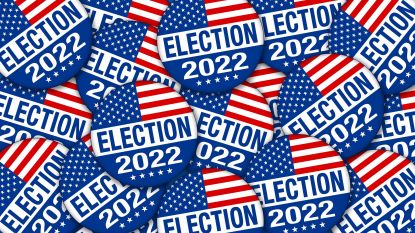The United States has midterm elections on Tuesday, Nov. 8. The midterms will determine control of the Senate and the House of Representatives, as well as the governorships of 36 states, including large population ones like California, Florida, New York and Texas.
This promises to be the most significant and critically important election in memory.
Except here’s the thing. Every election every two years always promises to be the most significant and critically important election in memory.
Subscribe to Kiplinger’s Personal Finance Be a smarter, better informed investor.
Save up to 74%
Sign up for Kiplinger’s Free E-Newsletters Profit and prosper with the best of Kiplinger’s expert advice on investing, taxes, retirement, personal finance and more – straight to your e-mail.
Profit and prosper with the best of Kiplinger’s expert advice – straight to your e-mail.
In behavioral finance, we would refer to this as a recency bias, and it’s a normal human impulse. We tend to place undue importance on current events, and it is only with the passing of time that we can gauge their true significance. And while some elections really are more significant than others, few prove to be watershed moments in history.
These midterm election races seem to be centered more on social issues such as reproductive rights and the ongoing investigations of former President Donald Trump. And while millions of Americans care passionately about these issues, they generally don’t have much of an impact on the economy or the markets.
That said, this year’s midterms do have implications for investors. A Republican sweep of Congress would effectively make President Joe Biden a lame duck for his remaining two years in office. As Republicans would control the legislative agenda, Biden would essentially have the choice of moving rightward or accepting paralyzing gridlock.
A Democrat sweep of Congress would leave the legislative agenda in that party’s hands, but unless they were to pick up at least two Senate seats – which is not out of the question by any means – we wouldn’t be likely to see significant, groundbreaking legislation over the next two years. West Virginia Senator Joe Manchin and Arizona Senator Kyrsten Sinema have effectively served as brakes on some of the Biden administration’s more ambitious plans.
A split Congress in which Republicans take control of one house (likely the House of Representatives) and the Democrats maintain control of the other (likely the Senate) has a good chance of paralyzing the government for the next two years.
It’s still early, but this third scenario would seem the most likely. As of late September, forecasting site FiveThirtyEight gives the Republicans a 69 in 100 chance of taking the House in the midterms and the Democrats the exact same odds of keeping the Senate.
Let’s consider some possible implications the midterm elections could have for investors.
Midterms Could Impact InflationFederal Reserve monetary policy tends to have the biggest impact on inflation, and the midterm elections should have no impact on the Fed. But, government spending and policy also plays a role. All else equal, government spending tends to goose aggregate demand and contribute to inflation.
So, a Democrat sweep would be seen as “inflationary” if it meant the possibility of a major spending hike.
Any other scenario – Republican sweep or a split Congress – would mean some degree of gridlock and a smaller likelihood that a major new spending bill gets passed. Congress is Congress, and it will find a way to burn through our tax dollars regardless of who controls each house. But major new programs would likely be off the table.
Major Tax Changes UnlikelyMajor changes to the tax code are unlikely regardless of what direction the election goes. If the Democrats were to make major gains in the Senate and maintain control of the House, it’s not inconceivable that we would see tax hikes.
The Inflation Reduction Act, for example, modestly raised corporate taxes by eliminating certain loopholes and introduced a 1% tax on stock buybacks. With a stronger majority, the Democrats would potentially look to raise taxes on higher-income Americans.
The more likely outcome, of course, is some form of split government, which would mean no major changes to the tax code for at least the next two years.
A Split Congress Bodes Well for StocksStocks perform fantastically well under Democrat presidents. They also perform fantastically well under Republican presidents.
All political mantras aside, the White House just doesn’t have as much power over the stock market as we seem to think.
But what about Congress?
It turns out that a split Congress might be the best of all worlds. Writing for Forbes, Mike Patton did an analysis of the 75 years ending in 2020 (opens in new tab). He found that the average annual return for the Dow Jones Industrial Average over that period was 8.3%. Yet, the return when Congress was split was significantly higher, at 12.9%.
Now, we should take data like this with a grain of salt. Correlation is not causation, and we shouldn’t assume that the market outperformed because the Democrats controlled one house and the Republicans the other. Ultimately, earnings, valuations, Fed policy and other factors are far more likely to drive stock returns rather than the outcome of the midterm elections. But perhaps we can conclude that, at a minimum, a split Congress isn’t bad for the market.
